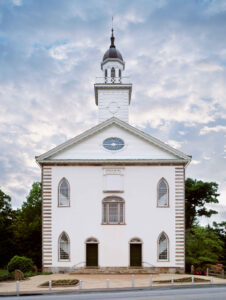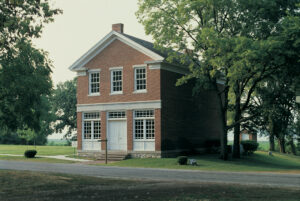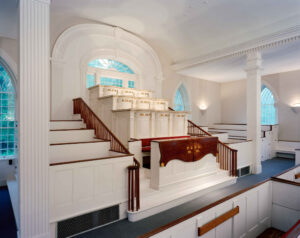 By David W. Smith
By David W. Smith
On March 5, 2024, Community of Christ and The Church of Jesus Christ of Latter-day Saints jointly announced that, after years of discussion, Community of Christ had sold to the Church of Jesus Christ the iconic Kirtland Temple, several historic sites in Nauvoo, and many historical documents and artifacts.
This announcement was met with joy by many members of The Church of Jesus Christ of Latter-day Saints (or Latter-day Saints) and with sorrow by many members of Community of Christ. As Latter-day Saints celebrate receiving ownership of these important historical assets, we can also “mourn with those that mourn” (Mosiah 18:9) in Community of Christ who are devastated at having to part with these cherished pieces of history.
History of the Assets
After years of toil and devoted effort, in 1836 the Church of the Latter-day Saints (as it was then called) completed the House of the Lord in Kirtland, Ohio. Joseph Smith—the president of the Church—dedicated the building on March 27, 1836. Contemporary and reminiscent accounts by the Saints attest to a marvelous outpouring of the Holy Spirit during this dedicatory period, when there were miracles and visits by heavenly messengers.
Sadly, over the next year and a half, tensions between various groups of members escalated. Joseph Smith and those willing to follow him left Kirtland and moved to Missouri. From there they moved to Illinois in 1839 and established a city called Nauvoo. As Saints gathered from throughout North America and Britain, the city quickly became one of the largest cities in the state of Illinois.
Due to religious and political difficulties, mobs were formed in 1844 to harass the Saints, eventually leading to the martyrdom of Joseph Smith. After his death, a majority of the Saints followed Brigham Young, president of the Quorum of the Twelve Apostles, past the western boundaries of the United States. They settled near the Great Salt Lake in what eventually became the state of Utah and continued The Church of Jesus Christ of Latter-day Saints.
 A small group of Saints, including Emma Smith (Joseph Smith’s wife) and her children, remained in Nauvoo and the surrounding area. They received possession of many important buildings connected to Joseph Smith and cared for those buildings. They also retained important historical documents, including papers used by Joseph Smith in preparing his inspired revision of the Holy Bible. Eventually they established a church that was later named the Reorganized Church of Jesus Christ of Latter-day Saints (RLDS). Through gifts and legal proceedings, this church eventually acquired title to several historic properties and assets in Kirtland, Ohio, and Nauvoo, Illinois, including the Kirtland Temple.
A small group of Saints, including Emma Smith (Joseph Smith’s wife) and her children, remained in Nauvoo and the surrounding area. They received possession of many important buildings connected to Joseph Smith and cared for those buildings. They also retained important historical documents, including papers used by Joseph Smith in preparing his inspired revision of the Holy Bible. Eventually they established a church that was later named the Reorganized Church of Jesus Christ of Latter-day Saints (RLDS). Through gifts and legal proceedings, this church eventually acquired title to several historic properties and assets in Kirtland, Ohio, and Nauvoo, Illinois, including the Kirtland Temple.
The RLDS church cared for these properties and assets carefully for over 150 years. When they changed their name to Community of Christ, they continued to care for these important pieces of their past. They made iconic places such as the Kirtland Temple and buildings in Nauvoo available for public tours and worked diligently to maintain these important pieces of history. They graciously shared access to important historical documents.
The Kirtland Temple was a foundational historic asset to Community of Christ, evidence to them of God’s spirit working in the lives of people on earth. It was a testament to their place as a “prophetic people” called to bring the shalom of Christ to all people on earth. And the properties in Nauvoo were ancestral homes of their church founders and leaders. From these buildings, RLDS church president Joseph Smith III, the son of the martyred Joseph Smith, began the process of building up that church from the scattered Saints in Illinois and the Midwest.
 These properties are also important to Latter-day Saints. The Kirtland Temple was the place where Jesus Christ appeared and where ancient prophets came to give authority to Joseph Smith to build up God’s kingdom on earth. Nauvoo is an essential part of the Latter-day Saint story. In this place the Relief Society was established, the largest women’s organization in the world. Also in this place, sacred rituals called temple ordinances were given for the first time.
These properties are also important to Latter-day Saints. The Kirtland Temple was the place where Jesus Christ appeared and where ancient prophets came to give authority to Joseph Smith to build up God’s kingdom on earth. Nauvoo is an essential part of the Latter-day Saint story. In this place the Relief Society was established, the largest women’s organization in the world. Also in this place, sacred rituals called temple ordinances were given for the first time.
Both Community of Christ members and Latter-day Saints cherish Kirtland and Nauvoo and the important place these properties have in their shared history.
Financial Difficulties
Community of Christ has been facing financial difficulties for decades. Beginning the mid-1980s, expenses exceeded income, a trend that has mostly continued to today. Through various initiatives and efforts, Community of Christ has been able to maintain a majority of its personnel and programs, though occasionally having to make major reductions.
In a December 2019 financial update, Community of Christ noted that “contributions to Mission Tithes have been declining for more than 25 years” and that “the decline is based on the loss of contributors.” Causing further difficulties, “almost 80 percent of Worldwide Mission Tithes are given by those [age] 60 and older.”
The trend of losing contributors and donations was accelerated by COVID-19. Between 2019 and 2023, the number of worldwide mission tithe contributors younger than age 50 dropped by half. Also in 2023, 48 percent of worldwide mission tithe contributions came from members aged 75 and older.
Let those numbers sink in a bit. This means that almost half of worldwide mission tithes are coming from people who will likely die in the next 5 to 10 years. And the very large demographic group of people younger than 50 are not replacing them. In fact, that group has stopped contributing in droves. To lose half of contributing people younger than 50 in four years is staggering.
In 2020, Community of Christ was able to prepare a budget to sustain current programs and ministries through 2023 (later extended to 2024). But funding in 2025 and beyond was in peril. In their financial report to the church in December 2023, Community of Christ Presiding Bishopric warned:
We’re facing the possibility of significant budget reductions. These reductions would include staff reductions and would significantly impact our capacity to provide current services and ministries to the church at International Headquarters and throughout the field. Reductions in the last decade have resulted in inadequate staffing levels to support current and future needs. We are beyond the ability to trim back expenses. Entire groups of support services and ministries would have to be eliminated.
In an effort to compensate for decreased contributions, Community of Christ has been selling significant property and historical assets for over a decade. It sold large tracts of land in Missouri in 2012, the printer’s manuscript of the Book of Mormon in 2017, and more land in Missouri in 2022. These sales allowed Community of Christ to convert real estate and historical assets into market investments that could be added to a financial endowment that would provide regular income to the annual budget.
Despite these efforts, the gap between income and expenses continued to rise. In December 2023, Community of Christ Presiding Bishopric noted that they were:
Exploring and implementing new sources of income to build endowments and sustain our global mission. This will include an evaluation of how to best utilize all our assets to support our vision and mission. . . . The Presiding Bishopric along with church leaders have been working on strategies related to alternate income such as those listed above for multiple years. There are numerous possibilities still being explored and some that are currently in progress. We are reasonably confident that resources will become available in 2024 to help offset the expected loss in income due to decreasing Worldwide Mission Tithes.
They also noted:
In the future we will continue to evaluate the best use of all physical assets to support mission. In some cases, this evaluation will lead to the conversion of physical assets (such as buildings and property) to liquid assets so those funds can be used for new mission opportunities locally and globally into the future.
Both Community of Christ members and Latter-day Saints would learn shortly what those assets and resources would be.
A Heartbreaking Decision
Faced with this difficult financial situation, Community of Christ leaders began discussions in June 2021 with The Church of Jesus Christ of Latter-day Saints on the possible sale of historic assets. Even considering selling such historic assets as the Kirtland Temple was devastating, as described by multiple leaders in Community of Christ:
- Stephen Veazey, president of Community of Christ: “I agonized over the impact that selling these historic sites would have on members and friends who deeply valued the church’s ownership. On occasion I wept tears of concern for the disappointment and grief some would experience.”
- Stassi Cramm, member of the First Presidency: “Initially, when we explored possibilities, I was convinced there had to be a way to fortify the church financially without resorting to this sale. The idea of selling these cherished physical assets seemed unimaginable.”
- Ron Harmon, presiding bishop: “The decision to sell historic assets was not an easy one. It was decision filled with emotion.”
- Lachlan Mackay, Apostle and descendant of Joseph Smith: “[I] spent 15 years living literally in the shadow of the Kirtland Temple . . . [and] have lived on the Joseph Smith historic site [in Nauvoo] for 18 years. These places have been my home for almost my entire adult life. . . . The Nauvoo House, Homestead, and Mansion House are my ancestral homes. For me, the decision to part with these places has been devastating emotionally. There was a time when I thought it might break me.”
Community of Christ leaders looked for various options to increase funding, but no other options became available that could cover the significant budget gap that was looming. Carla Long, member of Community of Christ Presiding Bishopric, explained:
Although leaders across the church have been discerning and responding to changing ministry contexts, change takes time. Also, some cultural trends impacting church participation are beyond our control. These factors led to the sale of Historic assets as the only remaining assets that could sufficiently fund endowments and in part generate the needed income over time to change our trajectory in some parts of the world.
Despite the pain at losing ownership of cherished historic assets, Community of Christ leaders are confident that selling these assets will position their church to continue its mission for years to come:
- Stephen Veazey: “I felt rising hope for the future that the proceeds would make possible.”
- Stassi Cramm: “Leaders came to understand that letting go of these physical assets—as painful as it was—would generate financial resources to invest in our current and future mission. . . . As we discerned about the future, it became increasingly clear that parting with these precious sites and items was the best way to embrace the opportunities to serve God through serving others. The realization dawned that we were choosing people over property and paper. This became a guiding principle that bolstered us when the prospect of proceeding with the sale felt unbearable. Even as we mourned the loss, the potential opportunities of the future fueled our hope. Completing this sale emerged as a crucial step in strengthening our response to wherever the Spirit leads us.”
- Scott Murphy, member of First Presidency: “I found solace in seeing this decision as an investment in our future, providing capacity to grow our response to Christ’s mission of seeking justice, pursuing peace, and creating sacred communities that reflect God’s vision of shalom for the world.”
- Lachlan Mackay: “If I inherited anything from Joseph Smith III, it’s his pragmatism, and intellectually the path forward is clear. I care deeply about our past, but I care even more about our future. The post-pandemic world has changed. The needs have never been greater, and we no longer have the resources, human or financial, to care for these places the way they deserve to be cared for. . . . The proceeds from the sale, at some level, are an extraordinarily generous gift from [the Smith family] that will sustain us as we move into the future. I think they would feel good about that. Amid my grief, so do I.”
A Time of Rejoicing
In the joint statement announcing the change, Russell M. Nelson, president of The Church of Jesus Christ of Latter-day Saints, stated, “We are deeply honored to assume the stewardship of these sacred places, documents and artifacts.” Latter-day Saints are grateful and excited for the opportunity to care for these treasured pieces of the past.
Latter-day Saints also recognize the great efforts made by generations past in Community of Christ to preserve and maintain these assets. “They have taken that calling [of stewardship] seriously and, even when it was costly to do so, they did their best to maintain those properties,” notes historian Benjamin Park. However, as Community of Christ Apostle Lachlan Mackay noted above, the Community of Christ no longer has the resources to care for these facilities in a way to preserve them into the future. By transferring ownership to the Church of Jesus Christ, Community of Christ ensures that these assets will be sustained for generations to come.
Through generous funding for historical efforts, the history department of the Church of Jesus Christ will be able to preserve these properties and assets in pristine condition and make them available to all who are interested, free of charge.
At this time of both heartbreak and rejoicing, Community of Christ members can find hope that this sale will enable their church to “have greater capacity to pursue our mission priorities around the world,” as noted by Stephen Veazey. They can find peace and joy through Jesus Christ, who will “comfort all who mourn, and provide for those who grieve in Zion” (Isaiah 61:2–3, NIV). And both Community of Christ members and Latter-day Saints can find joy knowing that these cherished pieces of our shared past will be well-preserved for generations to come.
 David W. Smith has volunteered with FAIR since August 2019. He has had an article published in BYU Studies, and he presented at the Joseph Smith Papers Conference in 2019. He has a bachelor’s degree in philosophy and a master’s degree in public administration, both from Brigham Young University.
David W. Smith has volunteered with FAIR since August 2019. He has had an article published in BYU Studies, and he presented at the Joseph Smith Papers Conference in 2019. He has a bachelor’s degree in philosophy and a master’s degree in public administration, both from Brigham Young University.
The post Rejoicing and Mourning: Context for Selling the Kirtland Temple appeared first on FAIR.
Continue reading at the original source →



